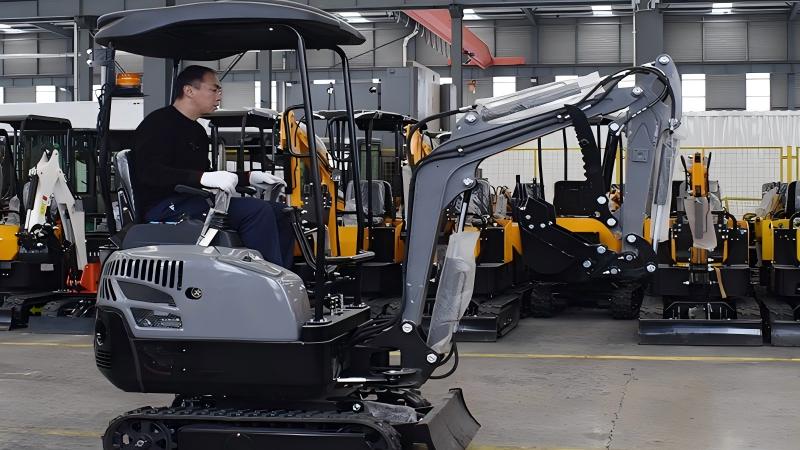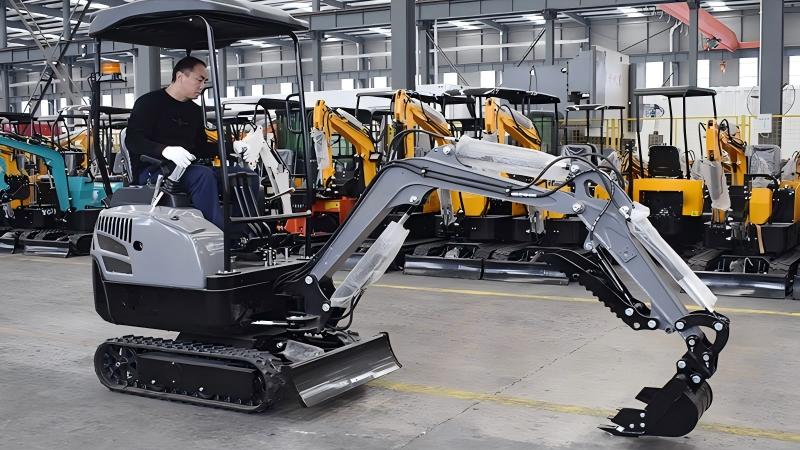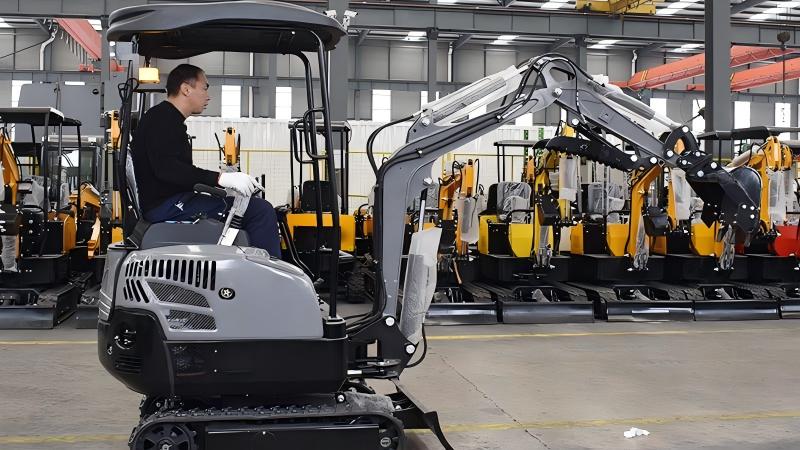Advantages of Mini Excavators in Landscaping:
Superior Digging Capabilities: This is where mini excavators truly shine. Their articulated arm allows for deep, narrow, and precise digging, making them ideal for:
Trenching for irrigation, drainage, or utility lines: Their ability to dig clean, consistent trenches reduces the need for manual labor and ensures proper water flow.
Pond and water feature excavation: The controlled digging motion allows for the creation of intricate shapes and varying depths required for water features.
Foundation work for retaining walls, patios, and sheds: Accurate digging of footings is crucial for structural integrity.
Stump removal: The powerful digging force can effectively extract stubborn tree stumps.
Grading and leveling in confined spaces: While not their primary function, with a skilled operator, they can perform fine grading in areas where a skid steer might struggle to maneuver.
Precision and Control: The independent movement of the boom, arm, and bucket provides operators with exceptional control, allowing for delicate maneuvers around existing structures, trees, and landscaping elements. This precision minimizes damage to surrounding areas.
Maneuverability in Tight Spaces: Their compact size and zero or reduced tail swing (depending on the model) enable mini excavators to work effectively in constricted areas, such as residential backyards, between buildings, or densely planted gardens, where larger equipment would be impractical.
Versatility with Attachments: Beyond digging, mini excavators can be equipped with a range of attachments, expanding their utility:
Hydraulic hammers/breakers: For breaking up concrete, rock, or asphalt.
Augers: For drilling post holes for fences, decks, or tree planting.
Grapples: For lifting and moving logs, brush, or demolition debris.
Compactors: For compacting soil in trenches or around foundations.
Ripper teeth: For breaking up compacted soil or frozen ground.
Reduced Ground Disturbance: Their tracks distribute weight evenly, resulting in less compaction and disturbance to the underlying soil, which is beneficial for maintaining the health of the landscape.
Disadvantages of Mini Excavators in Landscaping:
Limited Material Handling Capacity: While they can move excavated material, their primary design is for digging, not for efficient loading and transporting large volumes of material over distances. This often requires a secondary machine or method for material removal.
Slower Travel Speed: Mini excavators are not designed for rapid movement around a job site. Their travel speed is significantly slower than that of a skid steer.
Less Effective for Grading Large Areas: While they can do fine grading, their limited reach and bucket capacity make them inefficient for grading large, open areas that require a lot of material spreading and leveling.
Higher Purchase Cost (Generally): While prices vary widely, a similarly sized mini excavator may sometimes have a higher initial purchase price than a skid steer.
Learning Curve for Operators: Mastering the independent controls of a mini excavator can take more time and practice compared to a skid steer, especially for nuanced tasks.
Skid Steer: Power and Material Handling Versatility
Skid steers, also known as skid-steer loaders, are characterized by their rigid frame and lift arms used to attach a wide variety of buckets and other tools. They are typically wheeled, though track versions (compact track loaders or CTLs) are also very popular, offering improved traction and flotation. Their defining characteristic is their ability to push, load, and move materials with impressive speed and power.
Advantages of Skid Steers in Landscaping:
Exceptional Material Handling: This is the core strength of a skid steer. They excel at:
Loading and unloading trucks with bulk materials: Dirt, gravel, mulch, sand, and aggregates can be moved quickly and efficiently.
Spreading materials: Leveling and spreading topsoil, gravel, or mulch over large areas is a fast and efficient process.
Hauling debris: Clearing construction debris, branches, or other waste from a site.
Snow removal: With a snow push or blower attachment, they are highly effective for clearing pathways and driveways.
Speed and Maneuverability (Wheeled Models): Wheeled skid steers are incredibly agile and can move quickly around a job site, significantly reducing cycle times for material transport. They can also turn within their own footprint, making them highly maneuverable in tight spaces despite their larger size compared to mini excavators.
Versatility with an Extensive Array of Attachments: Skid steers boast an even wider range of attachments than mini excavators, making them incredibly versatile:
Buckets (various types): General purpose, dirt, rock, grapple, 4-in-1, etc.
Forks: For lifting and moving pallets of sod, pavers, or other materials.
Augers: For drilling post holes.
Trenchers: For digging narrow trenches (though less precise than an excavator).
Tillers: For preparing garden beds or breaking up compacted soil.
Brush cutters/mulchers: For clearing overgrown areas.
Sweepers: For cleaning up job sites.
Grading blades and box scrapers: For precise grading and leveling.
Pallet forks: For moving palletized materials like sod, pavers, or plants.
Powerful Pushing and Grading Force: Skid steers are excellent for pushing and leveling earth, making them highly effective for rough grading, preparing subgrades for patios, or leveling out building pads.
Relatively Simple Operation: The control scheme of a skid steer is often considered more intuitive for new operators compared to the complex joystick movements of an excavator.
Disadvantages of Skid Steers in Landscaping:
Limited Digging Depth and Precision: While they can dig, their primary function is pushing and loading. They are not designed for deep, narrow, or precise digging tasks. Trying to dig a trench with a skid steer is often inefficient and results in wider, less uniform trenches.
Ground Compaction (Wheeled Models): Wheeled skid steers can cause significant ground compaction, especially on soft or wet terrain, which can be detrimental to soil health and plant growth. Compact track loaders (CTLs) mitigate this issue.
Less Ideal for Confined Spaces (Compared to Mini Excavators): While maneuverable, their fixed frame and larger footprint can make them challenging to operate in very tight, confined spaces where a mini excavator with its independent arm movement can reach.
Damage to Existing Landscape: Due to their turning method (skidding), wheeled skid steers can scuff and damage existing lawns or delicate surfaces if operators are not careful, especially during sharp turns.
Dust Generation: Operating a skid steer, especially on dry, loose soil, can generate significant dust, impacting air quality and visibility
Mini Excavator vs. Skid Steer: Which is Better for Landscaping?
The answer to this question is not a simple "one-size-fits-all." The "better" machine depends entirely on the primary types of tasks you will be performing and the characteristics of your job sites.
Choose a Mini Excavator if your primary landscaping tasks involve:
Extensive digging: Trenching, digging foundations, excavating ponds, stump removal.
Precision work: Working around existing utilities, delicate landscaping, or in very confined spaces.
Site preparation requiring deep or narrow excavations.
Projects where minimizing ground disturbance is crucial.
Choose a Skid Steer (or Compact Track Loader) if your primary landscaping tasks involve:
Significant material handling: Loading, unloading, spreading large volumes of soil, gravel, mulch.
Rough grading and leveling large areas.
Brush clearing and site cleanup.
Projects where speed and efficiency in moving materials are paramount
Versatility across a wide range of surface-level tasks with numerous attachments.
The Ideal Scenario: Owning Both
For professional landscaping businesses that handle a diverse range of projects, the optimal solution is often to have both a mini excavator and a skid steer (or CTL). This combination provides the ultimate versatility, allowing you to tackle virtually any landscaping challenge efficiently. The mini excavator handles the precision digging and excavation, while the skid steer manages the material handling, grading, and surface-level work. This synergistic approach maximizes productivity and minimizes reliance on manual labor.
Considerations Beyond Core Function:
Budget: Assess your upfront investment capacity.
Transport: Consider how you will transport the machine to and from job sites. Skid steers are often easier to trailer due to their simpler shape.
Operator Skill: Evaluate the skill level of your operators or the time you are willing to invest in training.
Maintenance: Factor in the ongoing maintenance costs for each type of machine.
Attachment Costs: While both have vast attachment options, the specific attachments you need will add to the overall cost.
Job Site Accessibility: How easily can the machine get to and operate in your typical work environments?
Conclusion:
Both mini excavators and skid steers are invaluable assets in the landscaping industry. The mini excavator excels in precision digging and working in tight spaces, making it indispensable for tasks requiring meticulous excavation. The skid steer, on the other hand, is a powerhouse for material handling, grading, and a wide array of surface-level tasks, offering speed and unmatched attachment versatility. By carefully analyzing your project requirements, budget, and operational preferences, you can make an informed decision that will significantly enhance your landscaping efficiency and success. For those with the means, the combination of both machines represents the pinnacle of landscaping equipment capability.
Post time:Sep-25-2020



